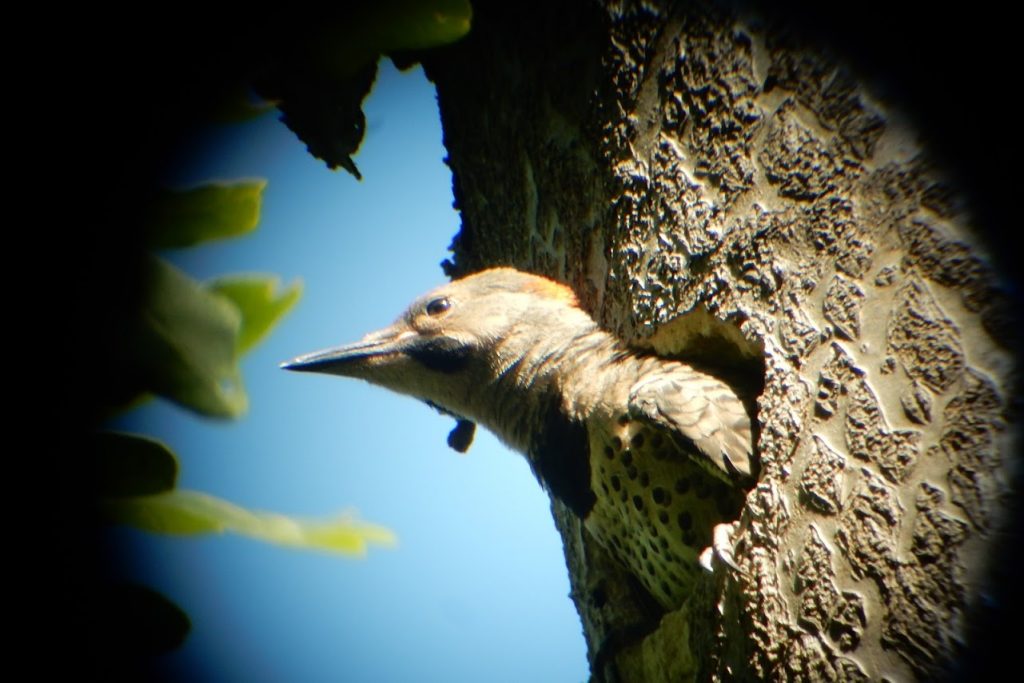- ABOUT US
- WHAT WE DO
- SPACES SERVED
Overview and map
of all spaces - RESOURCES
- GET INVOLVED
- ABOUT US
- WHAT WE DO
- SPACES SERVED
Overview and map
of all spaces - RESOURCES
- GET INVOLVED
- DONATE
Overview and map
of all spaces
Overview and map
of all spaces

The birding experts leading the walk, Dan and Georgia from the Baltimore Bird Club, lower expectations as they hand out a sheet of paper depicting common birds of Baltimore. The spring migration has been and gone and there might not much to see other than the usual robins, cardinals, crows, and house sparrows. That’s okay with Denise, who is active in the Winston-Govans Neighborhood Improvement Association. “I like to be in nature. I watch the birds in my back yard. There are more than there used to be, like the blue jays. They disappeared for a long time, but now they’re back with a vengeance!”
Denise’s friend Stephen agrees. Not only are there more birds, but more animals generally. Stephen has worked to clean up the local forest patches. “There’s more deer and foxes, and less trash so animals can survive and stay in the woods. Do you want to live in garbage? Well, neither do they!” Stephen’s mother taught him to forage when he was a boy, and he is happy to see the pecan and mulberry trees in the Wilson Park Woods and the Springfield Woods. “Where there’s food, there’s birds.”
It’s turning out to be a good birding day. The birding sheet is starting to fill up: catbird, downy woodpecker, red-tailed hawk, Carolina sparrow, turkey vulture, crow, starling, Baltimore Oriole, blue jay, white-breasted nuthatch, cardinal, song sparrow, mockingbird, robin, house sparrow.
Then a yellowish-brown bird flies out of leafy branches and settles on a branch on a dead tree in the sunlight, in clear view. It’s a northern flicker. Dan sets up his tripod and trains his scope on it. Everyone gets a close look at the flicker’s yellow-brown chest with brown dots, facial mustache, and bright red spot on top of its head. Then it flies away and disappears for a minute. Then it flies back, and away again, but it keeps returning to the dead tree. Someone spots the reason why the bird keeps coming back: a baby flicker has stuck its head out of a hole in the tree.

Dan finds a good spot for the tripod to get a good bead on the nest hole. One head, then two heads poke out of the hole as everyone lines up for a look. The parents are trying to stay cool as a dozen excited humans gawk at their babies, but the babies blow their cover by yowling for food.
At the end of the walk, Katherine and Eric agree that the baby flickers were the high point of the walk. Eric points out, “Whatever gets you out in nature, whether your interest is plants or trees or birds, it builds your connection to nature and to other people who care about nature.”
Katherine says, “You can’t have birds without plants. It’s all connected.” She adds, “Baltimore has an amazing network of naturalists and people who love city nature.”
Indeed – 52 people came out to the walks to listen for the birds’ small sounds, and catch some glimpses. The morning’s bird count was 209 birds, of more than 35 species. Many thanks to the Baltimore Bird Club, for making this wonderful event possible.
Want to be the first to learn about more forest events? Write to us at [email protected]. To support events like these, donate at baltimoregreenspace.org.

Be the first to hear about exciting events, news, and opportunities.
[email protected]
(813) 530-8166
2100 Liberty Heights Avenue
Baltimore MD 21217
Facebook | Instagram | Twitter